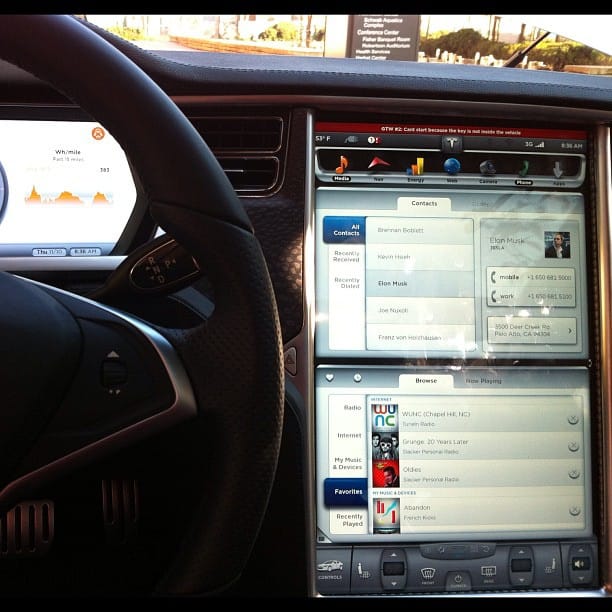IoT & Wearables: Driving

It is no secret that the motor and automaker industries are always trying to integrate new technology features in their vehicles in order to attract more customers. When it comes to IoT & wearables in driving, the trend is relatively similar.
Companies like Tesla are constantly pushing the envelope on what it means to operate a connected car while there is also quite a lot of experimentation happening with wearables in driving.
Today, we will take a brief look at these technologies and see how IoT & wearables may affect the auto industry of the future.
IoT and the connected car
While concerns about IoT, privacy, and security are on the rise, so are expectations and hope about the potential applications of the technology. In the vehicle industry, IoT is already here in the form of connected cars.
Using the example of the Tesla once more, it is remarkable to see how the industry has evolved in just a few years. The Model S’s absolutely massive touchscreen, combined with an integrated Internet system, was quite revolutionary and showed manufacturers a lot of new ideas.
We often talk about how IoT & wearables are set to be a huge industry by 2020. When talking in general terms, however, we often forget to see the smaller picture as well, which is vital in this case.
More specifically, connected cars are not just a concept; they are already happening. As car technologies evolve, most people find it unthinkable to go back to previous offerings. While not everyone can afford these new cars, there are a lot of new buyers who, when surveyed, have repeatedly expressed an interest in buying the latest and greatest in technology.
For instance, when Internet connectivity in all vehicles becomes the new standard, it will be hard to imagine driving a car that doesn’t even have a touchscreen of some kind.
Reports from virtually every research firm point towards the same things. BI Intelligence, for instance, believe that there will be 381 million connected cars on the road by 2020, a tenfold increase from 2015.
Improving the driving experience
For many people, the vehicle industry seems quite static. A car is a car, after all, and one might consider that there are few differences in the newer everyday models. What does change all the time, however, are the extra features offered by the manufacturers.
The user experience is one of the most important things in the industry right now. For instance, manufacturers have understood that on-board systems are often inferior to the ones provided directly by the likes of Google and Apple and have attempted to accommodate them.
A connected car and a mobile app can be the perfect match, particularly when assisted driving technologies also become the norm. Starting the car via an app, setting the right temperature, and putting your favorite playlist on before you even walk through the doors of your house is not a far-fetched dream, it is the near future.
When talking about concepts like this, there is a danger of sounding sensationalist or forgoing the current reality for promises of the future. The point here is not to tout the arrival of connected cars as the missing Holy Grail of the auto industry, but instead to highlight that the industry is already turning a lot of what used to be mere concepts into working, selling models.
Wearables in driving and how they can help
In fact, manufacturers in the auto industry are not the only ones who are invested in promoting IoT and wearables in driving. Plenty of other companies, startups and otherwise, understand that there is a lot of potential in a market that most people in the Western market area already invested in.
From safety to entertainment, wearables in driving are very likely to have a huge impact on how we use our cars and motorcycles. Take, for instance, the transportation industry. Truck drivers of the future may be equipped with wearables which will be connected to sensors in and out of the car, warning them about dangers in the roads, other cars in their blind spots, and a lot more.
In a more relatable example, the Peugeot Instinct concept car uses an iPhone app, a Samsung Gear S3 smartwatch, and some artificial intelligence to vastly improve the user experience, allowing the car to automatically adjust the driver’s seat, set the lighting to a mood-specific standard, or even turn on Netflix if there’s a passenger in the car.
On the other hand, Ford is focusing more on safety with a dedicated lab that has been testing all manners of wearable devices and their potential on-road applications.
For instance, a connected wearable system could alert drivers of accidents ahead or automatically adjust information systems based on the wearer’s current condition. So if you are tired and sleepy, such a system would allow more room for error.
Conclusion
IoT & wearables in driving are one of the most exciting markets, particularly because concepts turn into reality in a steady and quite efficient manner.
While many will be unable to test out these new systems, owing to the fact that purchasing a new car with all the bells and whistles is often prohibitively expensive, such technologies signal new trends which will one day become the standard of the industry.



